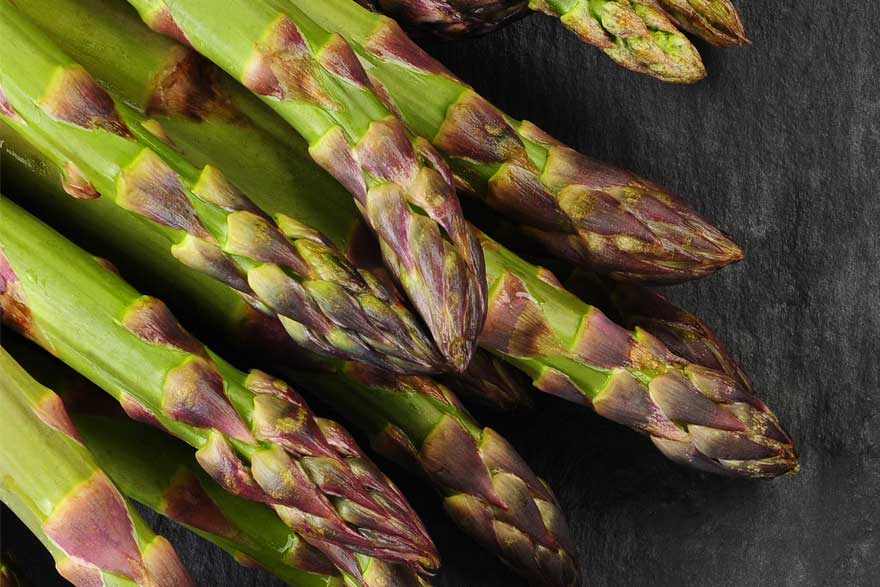By Trevett Hooper
Asparagus is near and dear to my heart, as are many of the things that grew in my parents’ garden. When it comes to foods like pineapples, I’m not much of a purist, most likely because I didn’t grow up with a pineapple tree in my backyard. But the plants I observed growing as a child were part of a story that I love to relive each year. Seeing that first asparagus poke out of the ground meant that winter was (almost, in most years) over. By the time the grown stalks arrived at the dinner table, spring was really here.
My own storyline with asparagus is one of the reasons I hold off cooking and eating it until the local stuff is available, which is usually the first week in May here in Western PA. But there is a bigger reason for waiting which anyone, even folks without personal experience with this precious vegetable, can appreciate: flavor.
Fresh, full-flavored asparagus lends itself well to simple cooking. My favorite method is boiling. Sometimes purchasing asparagus from a smaller-scale local farmer means a wider range of sizes than you might find in a bunch of mass-grown stalks. No problem. Just separate the different sizes as you bring some lightly—salted water to a boil. If you have fatter pieces, say over ¾” thick at the base, you might want to peel them with a vegetable peeler so the tips don’t get mushy before the base cooks, but you certainly don’t have to.
Once the water is boiling vigorously, the most precise way to cook asparagus is to boil one size at a time. Half-inch thick asparagus usually takes around 4-5 minutes. Peeled asparagus will cook faster than non-peeled. Simply remove the stalks with a slotted spoon or tongs (easier) when they’re done and move on to cooking the next-size pile. How do you know when they’re done? Pull one out of the water and eat it. I like asparagus that is fully cooked, as I think it has the most flavor. Other people like it more al dente. It’s really up to you.
A slightly easier, yet less precise method, which I am much more likely to actually use at home, is this: instead of cooking all the sizes separately, just start boiling the fat ones, add the mediums a minute later, and then the smalls a minute after that. You may have a few pieces here and there that are over—or undercooked, but it’s certainly not the end of the world, and not a bad trade—off if time is an issue.
Once the asparagus is boiled, let it drain for a minute in a colander, shaking for a few seconds to release as much water as you can, and serve on a platter dressed with some kind of fat. This would be a good time to splurge on one of the Co-op’s outstanding high-end cultured butters, such as Oasis Bird-in-Hand from Lancaster, or a great extra virgin olive oil, like the newly-available Bragg’s or Napa Valley Naturals. A squeeze of lemon juice or splash of vinegar would be nice too. (I’m a big fan of the Eden brand red wine vinegar these days.) If it needs salt (which it may, depending on how salty the cooking water was), this would be a great opportunity to use one of the Co-op’s fancy finishing salts such as fleur de sel or Maldon sea salt, which would add an interesting texture and flavor, but any salt will certainly do.
Be sure to cook some extra, too. Cold, leftover asparagus is great tossed with a simple vinaigrette or dipped in a homemade mayonnaise, both of which could be seasoned with some minced spring allium, such as ramps, spring onions, or green garlic—all available at different times throughout the spring season.
 Trevett is a Co-op member and the chef and co-owner of Legume Bistro, a family-operated restaurant located in the North Oakland neighborhood of Pittsburgh. Named a semi-finalist for Best Chef in the 2013 James Beard Foundation Awards, Trevett leads a team of curious cooks exploring old-fashioned methods of in-house food processing such as fermentation, canning, drying and whole animal butchery in order to cook with significant amounts of local ingredients throughout the year.
Trevett is a Co-op member and the chef and co-owner of Legume Bistro, a family-operated restaurant located in the North Oakland neighborhood of Pittsburgh. Named a semi-finalist for Best Chef in the 2013 James Beard Foundation Awards, Trevett leads a team of curious cooks exploring old-fashioned methods of in-house food processing such as fermentation, canning, drying and whole animal butchery in order to cook with significant amounts of local ingredients throughout the year.



Leave A Comment